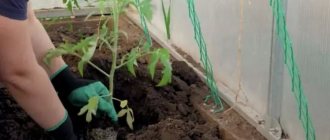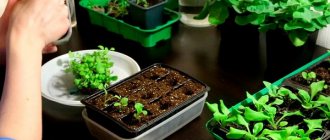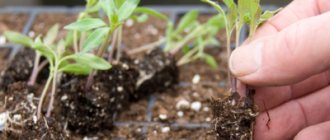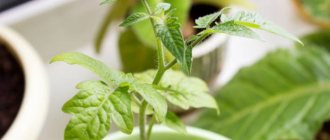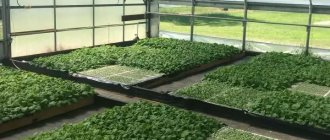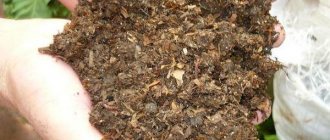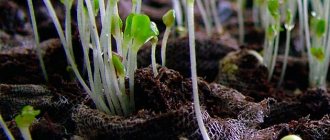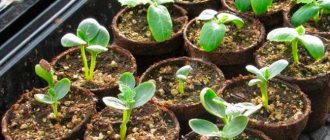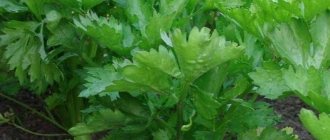Don’t know how best to feed tomatoes in a greenhouse? Our detailed article will help you understand this issue.
Even when growing tomatoes on fertile soil, you cannot do without regular fertilizing. Only proper care of plants, coupled with timely application of fertilizers, will ensure a rich harvest of healthy and beautiful fruits. At the same time, it is important not to overdo it with doses of fertilizing, otherwise the tomatoes may die.
When and what to feed?
When growing tomatoes in a greenhouse, it is easier to meet the necessary conditions (you can find out more about the main intricacies of fertilizing tomatoes in a greenhouse here). There is an opinion that the feeding regime is not so important and only adds unnecessary trouble. However, it is not. Even with fertile soil and proper watering, you can ruin the fruits if you use the wrong fertilizers.
The frequency of use and type of fertilizer for tomatoes depends on the stage of plant development (you can read more about the types and use of fertilizers, as well as the benefits of mineral fertilizers in this material). For example, seedlings need calcium and superphosphate. Before planting, seedlings are fertilized with yeast, which stimulates the growth of young tomatoes well. After planting, use a complex fertilizer so that the plants evenly absorb the minerals they need (you can find out more about choosing a complex fertilizer for tomatoes here).
At the beginning of flowering, tomatoes lack phosphorus and calcium, so these are the ones you should pay attention to when fertilizing. But nitrogen is not needed at all during this period. When fruit sets, ash is good, and it is also used during fruiting, adding mineral fertilizers containing iodine, potassium and other microelements. It is necessary to consider in detail the rules for feeding tomatoes at each stage of growth.
Advice from experienced farmers
With the beginning of each season, vegetable growers are concerned with questions: what fertilizers for feeding tomatoes in a greenhouse will be most effective, what new things are offered by the agro-industrial complex, etc. Experienced farmers recommend adhering to traditional growing methods, strictly following the instructions for timing and dosage. To protect greenhouse plants from diseases, you should:
- control soil acidity;
- use biological products with beneficial bacteria;
- apply fertilizers according to schedule;
- After harvesting, burn plant residues.
Some vegetable growers spread fresh manure around the site so that the ammonia destroys harmful microorganisms on the walls of the greenhouse, but this method has not become widespread due to its unproven effectiveness.
Growing tomatoes in greenhouse conditions requires complex influences: the use of mineral fertilizers and organic matter, chemicals against diseases and pests, as well as maintaining the level of humidity and temperature. A competent approach will be rewarded with a good harvest.
When to start using fertilizers for tomato seedlings in a greenhouse?
For the first time, seedlings are fertilized 48 hours after the cotyledon leaves develop on the sprouts.:
Use 2 g of calcium nitrate, diluted in 1 liter of water.- A week later, the plants are fed with energen diluted in water (the solution should be almost transparent, slightly yellowish).
- When 4 true leaves appear, you need to water the seedlings with a superphosphate solution. Compound:
- 10 g superphosphate;
- 1 liter of cold water.
- 6 days later, the plants are treated with calcium nitrate (2 g per 1 liter of water).
- When 8 pairs of true leaves appear, the young plants are again watered with superphosphate.
Before planting seedlings in the soil, it is better to feed them with yeast-based fertilizers. For this:
- dry yeast (1 packet) is mixed with two tablespoons of sugar and water (one glass);
- all ingredients are mixed and left for one and a half, two hours;
- the resulting mixture is diluted in water (half a liter of mixture per 10 liters of water) and fertilize young tomatoes.
You can find out more about a simple and effective yeast fertilizer for tomatoes here, and you can read more about recipes for fertilizing seedlings in this material.
Important! For tomatoes in a greenhouse, you need to prepare the soil in advance (either in the fall or in the spring before planting).
To make the land more fertile, a bucket of turf soil and peat (for every m2 of land) is poured onto the beds. Organic fertilizer is also added to them: half a liter of wood ash mixed with 10 liters of humus and 1 teaspoon of urea.
To avoid plant disease, the soil before planting is watered with a weak solution of potassium permanganate : 1 g of potassium permanganate and 10 liters of water (the water must be heated to at least 60 degrees).
You can learn more about the first and subsequent feedings for tomato seedlings here. You can find out more about the use of ash for feeding tomato seedlings at home here.
Nutrients required for greenhouse tomatoes
Tomatoes grown in greenhouses or greenhouses require mineral fertilizers containing:
- potassium;
- phosphorus;
- nitrogen.
Let us dwell in more detail on the question of what time and what to feed tomatoes in a greenhouse.
Nitrogen
Nitrogen fertilizers are needed at two main stages of tomato development:
- After transplanting into a greenhouse or greenhouse.
- After the formation of ovaries on the first two clusters of most tomato bushes.
As mentioned above, if the seedlings are very overgrown, and besides, they were grown in low light conditions, and after transplanting they remain weak and elongated, then after 10 days they can be fed with nitrogen-containing fertilizers. Such root feeding will give a powerful impetus to enhanced growth and development of the root system and the bush itself.
Ovaries on a tomato
After most tomato bushes have formed ovaries on the first two clusters, you can fertilize them with nitrogen fertilizers. At this time, the nitrogen added to the soil will not be used to form green mass, but will be directed to the development of fruits.
Potassium
The tomato is a very rapidly developing plant, which requires potassium for this purpose, which promotes the formation of stems, fruit set, the manifestation of varietal taste qualities, as well as a beautiful appearance. Among other things, potassium contributes to the resistance of tomatoes to various diseases. (See Tomato diseases in the greenhouse)
The greatest need for potassium fertilizers in tomatoes is during the following periods of development:
- During the opening of the third and fourth true leaves, when the generative organs of the plant are laid down.
- From the moment of formation of the ovaries, until the ripening of the fruit.
Signs of potassium deficiency on tomato leaves
If a tomato bush lacks potassium, then, as you can see in the photo, the plant “signals” about this:
- twisting the edges of the leaf blade;
- color change from deep green to yellowish-bronze;
- uneven ripening of fruits.
Phosphorus
Phosphorus fertilizers applied to the soil contribute to the resistance of plants to various unfavorable conditions, the development of a strong root system and good fruit set.
In addition, phosphorus is involved in the process of absorption of other nutrients by plants, in particular nitrogen.
If tomatoes are deficient in phosphorus, you can see this by the following signs:
- the leaf blade begins to curl along the main vein;
- red and purple spots appear on the underside of the leaf;
- slowing down the process of fruit ripening.
Tip: the first fertilizing of tomatoes in a greenhouse can be done while planting seedlings in a permanent place. To do this, add 10-15 g of superphosphate to each prepared well.
After landing
In the period from 3 to 5 days after planting the growing bushes in the greenhouse (usually the first days of June), they need to be fed with complex fertilizer, which contains:
- phosphorus;
- nitrogen;
- potassium.
At the same time, the main thing is not to overdo it with nitrogen, since the leaves will grow too actively, and on the contrary, there will be fewer fruits.
The climate in the greenhouse is more humid than in open ground, so the plants will absorb nutrients very quickly.
To ensure that microelements have time to be absorbed, it is better to reduce the concentration of fertilizers . This option is most optimal: 3 tsp. dilute nitrophoska, half a liter of mullein in 9 liters of water, pour 1 liter of fertilizer under the root of each bush.
Organic fertilizers for the first feeding of tomatoes
From organic fertilizers, you can use humus or slurry. Humus can be added dry to loosened and watered soil, 100 g per bush. The slurry must be diluted ten times with water, let the solution sit for three days and pour a liter onto the plant very carefully so as not to get on the foliage. It is best to fertilize with organic matter in the evening or morning, when it is not hot in the greenhouse.
- Humus can be added when planting tomatoes in a hole, 100 g per hole, then you can not add it.
- Slurry can be applied two weeks after planting the seedlings. This is the second feeding, you need a liter for each bush. Manure in the same amount must be applied again during the fruiting period; no further fertilizing is required.
Photo pixabay/kie-ker: Plants respond well to organic feeding.
Bloom
Proper feeding of greenhouse tomatoes during flowering will ensure good fruit set, so it is worth paying attention to. Fertilizers should contain potassium and phosphorus; it is these substances that tomatoes lack during the appearance of buds; nitrogen should be excluded altogether during this period (you can learn more about the types of phosphorus fertilizers in this material).
When the buds just begin to appear, the tomatoes need yeast feeding. The same fertilizer recipe is used as for seedlings before planting. In addition, you can add a little ash to the soil.
During flowering, it is recommended to perform one root feeding and one foliar feeding (more information about the best methods of foliar feeding can be found here). For root feeding, use: potassium sulfate (3 teaspoons), half a liter of bird droppings. All this is dissolved in 10 liters of water, after which half a liter of liquid mullein is added. Tomatoes are watered at the rate of 1 liter of fertilizer per 1 bush.
For active formation of ovaries, tomato bushes are sprayed with milk-based fertilizer: 15 drops of iodine, 1 liter of milk, dissolved in 4 liters of water, the leaves are treated in the morning and evening.
What fertilizers should be applied in the spring when planting tomatoes?
When choosing what fertilizers to apply when planting tomatoes, you will have to consider different groups of fertilizers:
- NPK complex;
- potassium and phosphorus additives;
- nitrogen fertilizers;
- microelements.
NPK is nitrogen, phosphorus and potassium. Industrial agrochemicals are produced in sealed packages with detailed instructions. The most common drugs were nitrophoska and azofoska. The first has a beneficial effect on the quality of the soil, promotes the growth of greenery and the formation of large tomatoes. The second is universal, both for crops and types of soil, improves the condition of the root system and strengthens the green part of the bushes.
Fertilizing with nitrogen is needed during rooting, green growth and fruit set. Fertilizer is applied 2 weeks before planting or immediately before it. The most popular compositions are urea and ammonium nitrate.
Compositions with potassium and phosphorus are used simultaneously. Both elements ensure the development of fruits, give them taste and color. Additions begin from the period of formation of buds and the first ovaries. In the fall, it is advisable to enrich the soil with potassium and phosphorus for future harvests. Potassium salt, monophosphate, potassium chloride, superphosphate are on sale.
Microelements are embedded in the soil in advance; fertilizing is not recommended when planting tomatoes. The main substances needed by the culture:
- potassium sulfate (harvest keeping quality);
- magnesium and zinc (immunity and fetal formation);
- boric acid (yield).
Fruit ovary
During fruit set, tomato tops are sprayed with an ash solution . Solution recipe:
- Dilute 2 cups of ash in 2 liters of water (preferably hot);
- leave for 48 hours;
- strain the infusion to remove sediment, and then dilute it again in water - up to a volume of 10 liters.
It is advisable to process plants in the evening or on cloudy days, when there is no direct sunlight.
Attention! When processing ash, tomato leaves must be dry.
Spraying tomatoes with ash
Tomatoes respond well to foliar spraying using wood ash. The solution can be made as follows:
- 1 tbsp. ash is poured into 1 liter of boiling water.
- The mixture is stirred and left for 2 days.
- After this, the precipitate is filtered off, and the resulting liquid is brought to a volume of 5 liters.
The nutritional composition of wood ash promotes the rapid formation of ovaries.
Fruiting
There are many fertilizer recipes for the appearance of healthy and tasty fruits. It is important to remember that during fruiting only root fertilizers are used. Here are some suitable options:
- Fertilizer with superphosphate . For 6 teaspoons of fertilizer there are 10 liters of water. Add a tablespoon of potassium humate to the solution. One liter of fertilizer should be poured under the root of each bush.
- Mineral fertilizer . This mixture contains iodine, manganese, potassium and boron, necessary for the formation of juicy and tasty fruits. 10 g of boric acid is dissolved in a liter of hot water, after which iodine (10 ml) and one and a half liters of ash are added. The mixture is also dissolved in a bucket of water (9-10 liters) and 1 liter is poured onto the bush. You can find out more about how to use iodine to feed tomatoes here.
- A mixture of organic and mineral fertilizers . Mix a liter of manure, 3 tsp in a bucket of water. mineral fertilizer and 1 g of manganese. Each bush requires one and a half liters of fertilizer.
This is the complete scheme for fertilizing tomatoes throughout the life of the plants. It is more clearly described in the tomato feeding schedule presented below.
Note : in the “Composition” column only one fertilizer option is indicated, which is used at one or another stage of growth, but it can be replaced with other options discussed in the article.
Foliar feeding
Microelements are mainly added through the leaves. Calcium and boron have already been mentioned above. Tomatoes also need: manganese, iodine, iron, copper, etc. All this is in complex mixtures for tomatoes (Red Giant, BioHumus, Bio Master, Clean Leaf, etc.). The instructions for each tell you how to do foliar feeding. But in the case of tomatoes, it is better not to overuse spraying. Carry them out only when absolutely necessary, for example, in bad weather, when the ground cools down to +10... +13 °C, and the roots are not able to absorb nutrition from the ground. By wetting the leaves, we create a favorable environment for the development of fungal diseases. In addition, foliar feeding will never replace full-fledged root feeding.
Video: leaf processing that is worth adopting
It is not difficult to understand the principle of fertilizing tomatoes in a greenhouse. The main thing is not to overfeed with organic matter and nitrogen mineral fertilizers. For tomatoes, apply only before planting. And then you need complex mixtures; feed them, focusing on the instructions and the condition of the bushes.
- Author: Marina Volkova
I live in Siberia. I have my own house and my own plot) In the articles I share my experience, I learn something myself together with you) Rate the article:
- 5
- 4
- 3
- 2
- 1
(46 votes, average: 4.3 out of 5)
Share with your friends!
Fertilizer application scheme in the table: timing and quantity
| № | Growth stage | Compound |
| 1 | 48 hours after the formation of cotyledon leaves | Calcium nitrate: 2 g per 1 liter of water. |
| 2 | 1 week later | Energen solution diluted to a transparent yellowish color. |
| 3 | 4 true leaves have grown | Superphosphate solution: 10 g (or 5 g double superphosphate) per 1 liter of water; dilute in heated water the day before watering. |
| 4 | 1 week later | Calcium nitrate: 2 g per 1 liter of water. |
| 5 | 8 true leaves have grown | Superphosphate solution: 10 g (or 5 g double superphosphate) per 1 liter of water; dilute in heated water the day before watering. |
| 6 | 1-2 days before planting seedlings | For 1 glass of water, 1 package of dry yeast and 6 teaspoons of sugar. The solution is infused for one and a half to two hours and diluted with 10 liters of water. |
| 7 | 3-5 days after landing | For 10 liters of water 3 tsp. nitrophoska and 0.5 l. mullein |
| 8 | Buds have appeared | For 1 glass of water, 1 package of dry yeast and 6 teaspoons of sugar. The solution is infused for one and a half to two hours and diluted with 10 liters of water. |
| 9 | Flowering has begun | Root feeding: For 10 liters of water 3 tsp. potassium sulfate + 0.5 liters of bird droppings (mix and add 0.5 liters of liquid mullein). Feeding for leaves: For 4 liters of water, 1 liter of milk and iodine (15 drops). |
| 10 | The first fruits have begun | Heat 2 liters of water to 60-70 degrees, add 2 cups of ash. Leave for 2 days, dilute in 10 liters of water. |
| 11 | The height of fruiting | For 10 liters of water 6 tsp. superphosphate and 3 tsp. potassium humate. |
Complex products for tomatoes
Modern specialized stores can offer fertilizers that satisfy any need. Information on methods of use and required dosages can be found in the instructions for each drug or obtained from a store sales consultant.
Often, experienced gardeners purchase complex fertilizers from the “Kristalon” series, which contain various micro- and macroelements that have a general strengthening effect on plants. These fertilizers are water-soluble, which makes them easy to use, and can replace manure, ammonium nitrate, and urea.
The action of this drug has a long-lasting effect: the active substances, when released into the soil, remain in it for 2 - 3 years. Does not pose an environmental hazard.
The Kemira mineral complex developed in Finland is especially popular. The complex contains all the necessary nutrients and microelements (nitrogen, phosphorus, potassium, magnesium, manganese, zinc and others). The granular fertilizer substance is packaged in sachets, with the weight indicated, which is very convenient when applying solutions. It is also found in liquid form. Does not contain chlorine.
The Effekton fertilizer , which is a natural substrate consisting of peat and mineral additives, is recognized as environmentally friendly and biologically active. “Effecton” improves the soil, promotes the development of beneficial microflora and is a stimulator of root growth.
Some researchers say that this fertilizer helps reduce the level of radionuclides and carcinogens in the soil.
Additional Tips
For a bountiful harvest and plant health, watering is no less important than fertilizing . When the tomatoes have buds, they need to be watered once a week, up to 5 liters of water under the roots of each bush. At the same time, you need to monitor the condition of the soil and avoid stagnation of water. During fruiting, the amount of water for irrigation decreases (up to 3 liters), but water more often: already twice a week.
It is also important to monitor the appearance of the plant: you need to feed the tomatoes additionally if there are signs indicating a lack of nutrients. Here are the most common cases:
- Phosphorus deficiency : The tomato stem turns purple, as does the underside of the leaves. If you feed the bush with a diluted solution of superphosphate, the problem will disappear in a day.
- Lack of calcium : plant leaves curl inward, fruits rot on top. In this case, a solution of calcium nitrate, which is sprayed on the leaves, helps.
- Nitrogen deficiency : Tomato growth slows down, the color of the tops becomes light green or light yellow, and the stems are very thin. Spraying with a very weak urea solution can help here.
Growing tomatoes may seem like quite a troublesome task, but if you follow all the recommendations covered here step by step and care for the plants correctly, juicy and tasty fruits are guaranteed.
When is emergency feeding useful?
Above was an approximate scheme for feeding tomatoes; in practice, the number of its stages can vary if necessary. Everything will depend on the condition of the soil and the development of the bushes.
If the condition of the plants is deteriorating (leaves, stems and other parts of the plant do not look healthy, become stained, deformed or dry out), this may indicate a deficiency of a specific element.
To improve the health of the bushes, you need to add the missing nutrition to the soil - carry out extraordinary plant feeding.
Rules for working with fertilizers
Each drug has instructions, which must be strictly followed so as not to exceed the recommended fertilizer rates and thus not cause harm to your body. Below are general rules and tips for using medications.
- The soil under the tomato bushes must be shed before applying fertilizer.
- Do not dilute fertilizers in cooking containers. They require separate dishes, preferably plastic ones, because... the metal may react with some elements included in the drug.
- It is necessary to use fertilizers more often in small packaging, which is designed for preparing one bucket. It's a little more expensive, but you don't have to weigh the drugs and they're easy to store.
- When feeding roots, try not to get it on the leaves of plants, as this can cause them to burn.
- If dry fertilizing is done, then the granules are lightly embedded in the soil without leaving them on the surface.

